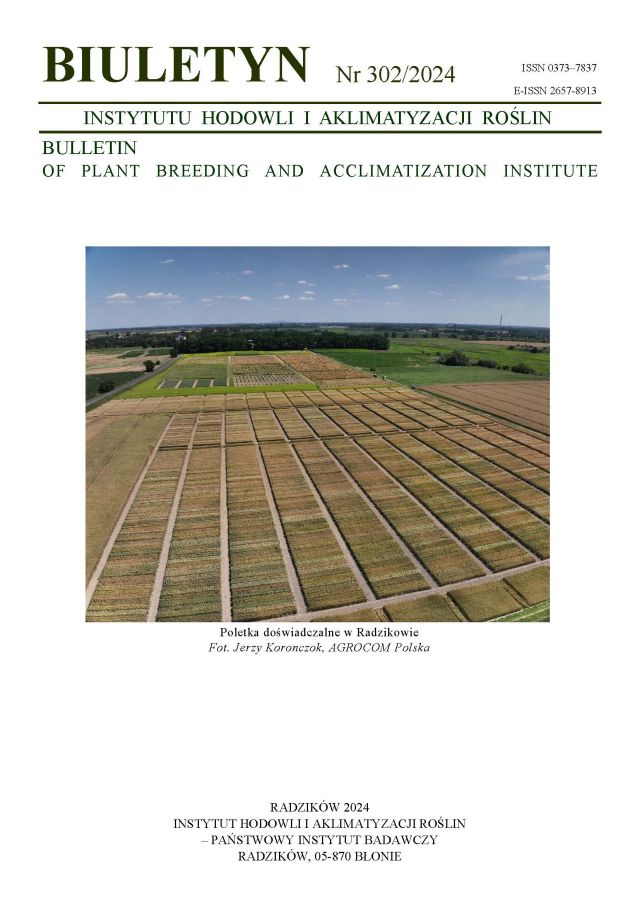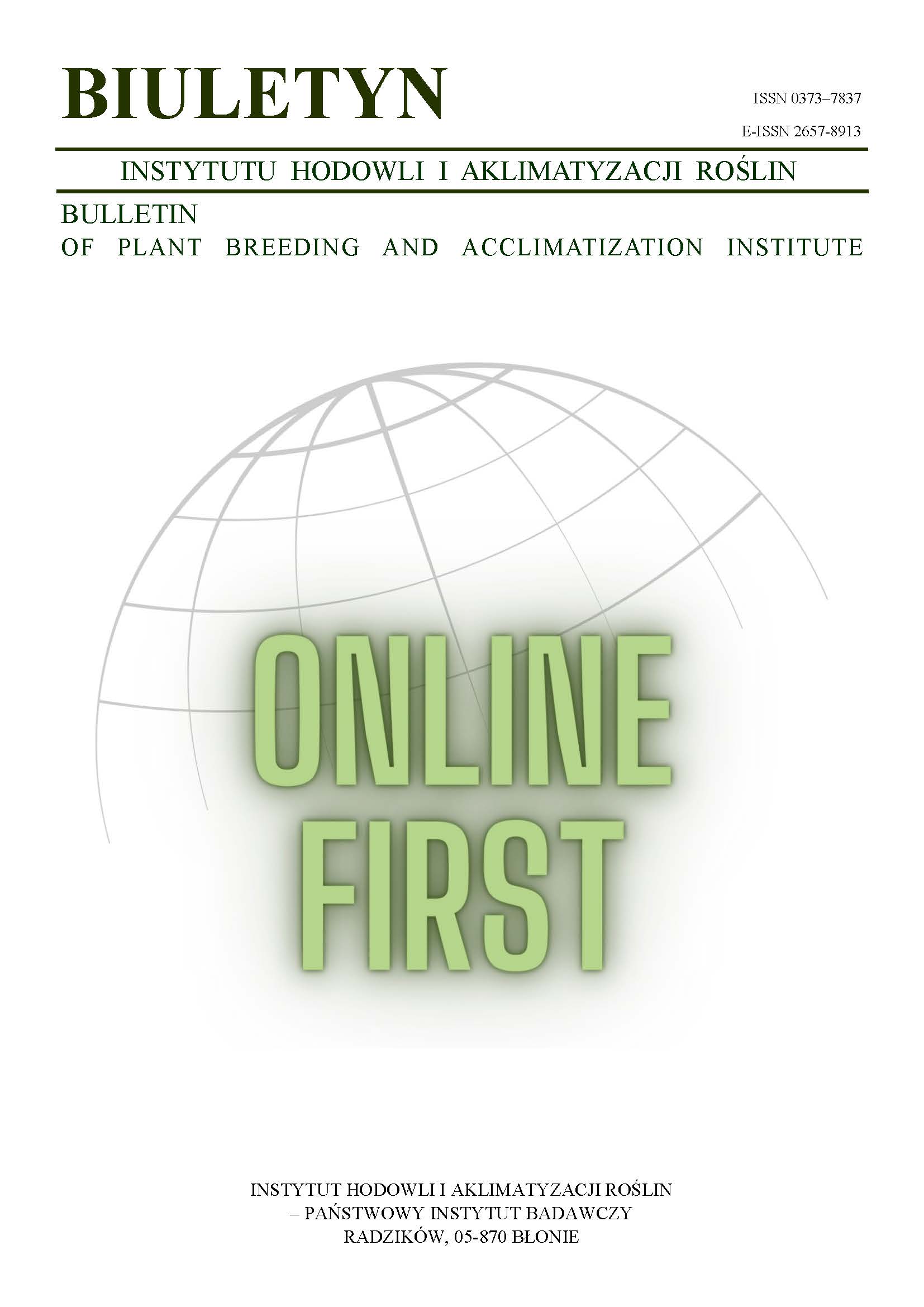Susceptibility of Polish wheat breeding lines to Puccinia graminis Pers.
Czesław Zamorski
czeslaw_zamorski@sggw.edu.plKatedra Fitopatologii, Szkoła Główna Gospodarstwa Wiejskiego, Warszawa (Poland)
Bogdan Nowicki
Katedra Fitopatologii, Szkoła Główna Gospodarstwa Wiejskiego, Warszawa (Poland)
Małgorzata Schollenberger
Katedra Fitopatologii, Szkoła Główna Gospodarstwa Wiejskiego, Warszawa (Poland)
Wojciech Wakuliński
Katedra Fitopatologii, Szkoła Główna Gospodarstwa Wiejskiego, Warszawa (Poland)
Abstract
Susceptibility of winter wheat genotypes to Puccinia graminis infection was tested on experimental plots of the Plant Pathology Department, Warsaw Academy of Agriculture, in the years 2000–2002. The evaluated wheat forms originated from the Polish breeding stations. The first infections of plants were caused by eciospores from barberry bushes and the secondary ones by urediniospores formed on leaves and sheaths of wheat. Provocative conditions during the experiments secured good development of stem rust. Infection degree of comparative combination plants (wheat cv. Gama) reached the highest value. Among the 2771 tested genotypes more than 74% were severely infected by Puccinia graminis. Genotypes free of stem rust symptoms constituted 16% of all tested forms. There was also a high percentage (74%) of very susceptible materials among winter wheat lines in the registration trials. These results show at urgent necessity of taking the stem rust into consideration in breeding work on wheat.
Keywords:
susceptibility, wheat, stem rustReferences
Kochman J. 1973. Fitopatologia. PWRiL, Warszawa.
Google Scholar
McIntosh R.A., 1988. The role of specific genes in breeding for durable stem rust resistance in wheat and triticale. Breeding Strategies for Resistance to the Rusts of Wheat. (Eds. N. W. Simmonds, S. Rajaram): 1–9, CIMMYT, Mexico.
Google Scholar
McIntosh R. A., Wellings C. R., Park R. F. 1995. Wheat rusts. An atlas of resistance genus. Kluwer Academic Publishers, Dordrecht.
DOI: https://doi.org/10.1071/9780643101463
Google Scholar
Nowicki B., Zamorski C., Wakuliński W., Schollenberger M. 2002. Response of wheat and triticale genotypes to infection by Puccinia graminis. Petria 12 (1/2): 271 — 275.
Google Scholar
Park R. F., Wellings C. R. 1992. Pathogenic specialization of wheat rusts in Australia and New Zealand in 1988 and 1989. Australian Plant Pathology 21: 61 — 69.
DOI: https://doi.org/10.1071/APP9920061
Google Scholar
Roa M. V. P. 1978. The transfer of alien genes for stem rust resistance to durum wheat. Proc. 5th Intern. Wheat Genet. Symp. (Ed. Ramanujam) New Dehli. India: 338 — 341.
Google Scholar
Roelfs A. P. 1978. Estimated losses caused by rust in small grain cereals in the United States — 1918-76. Miscellaneous Publication 1363. USDA, Washington DC.
Google Scholar
Roelfs A. P., Bushnell W. R. 1985. The cereal rusts. Vol. II. Diseases, distribution, epidemiology and control. Academic Press, Orlando.
Google Scholar
Roelfs A. P., Singh R.P., Sarri E. E. 1992. Rust disease of wheat. Concepts and methods of disease management. CIMMYT, Mexico.
Google Scholar
Sawhney R.N., Goel L.B. 1981. Race specific interaction between wheat genotypes and Indian cultures of stem rust. Theor. Appl. Genet. 60: 161 — 166.
DOI: https://doi.org/10.1007/BF00264522
Google Scholar
Smith J., Le Roux J. 1992. First report of wheat stem rust virulence for Sr 27 in South Africa. Vortrage für Pflanzenzüchtung 24: 109 — 110.
Google Scholar
Stubbs R. W., Prescott J. M., Saari E. E., Dubin H. J. 1986. Cereal Disease Methodology Manual. CIMMYT, Mexico.
Google Scholar
The T. T., Latter B. D. H., McIntosh R. A., Ellison F. W., Bremah P. S., Fisher J., Hollamby G. J., Rathjen A. J., Wilson R. E. 1988. Grain yields of near-isogenic lines with added genes for stem rust resistance. Proc. 7th Int. Wheat Genet. Symp. (Eds. Miller T. E., Koebner R. M. D.) IPSR, Cambridge, England: 901 — 906.
Google Scholar
Tomar S. M. S., Menon M. K. 2001. Genes for disease resistance in wheat. Indian Agricultural Research Institute, New Delhi, pp. 152.
Google Scholar
Zamorski C. 1995. Rozwój rdzy brunatnej oraz cechy diagnostyczne rdzy brunatnej (Puccinia recondita Rob. ex Desm) i rdzy źdźbłowej (Puccinia graminis Pers.) pszenicy. Biul. IHAR 194: 189 — 192.
Google Scholar
Authors
Czesław Zamorskiczeslaw_zamorski@sggw.edu.pl
Katedra Fitopatologii, Szkoła Główna Gospodarstwa Wiejskiego, Warszawa Poland
Authors
Bogdan NowickiKatedra Fitopatologii, Szkoła Główna Gospodarstwa Wiejskiego, Warszawa Poland
Authors
Małgorzata SchollenbergerKatedra Fitopatologii, Szkoła Główna Gospodarstwa Wiejskiego, Warszawa Poland
Authors
Wojciech WakulińskiKatedra Fitopatologii, Szkoła Główna Gospodarstwa Wiejskiego, Warszawa Poland
Statistics
Abstract views: 7PDF downloads: 5
License
Copyright (c) 2004 Czesław Zamorski, Bogdan Nowicki, Małgorzata Schollenberger, Wojciech Wakuliński

This work is licensed under a Creative Commons Attribution-ShareAlike 4.0 International License.
Upon submitting the article, the Authors grant the Publisher a non-exclusive and free license to use the article for an indefinite period of time throughout the world in the following fields of use:
- Production and reproduction of copies of the article using a specific technique, including printing and digital technology.
- Placing on the market, lending or renting the original or copies of the article.
- Public performance, exhibition, display, reproduction, broadcasting and re-broadcasting, as well as making the article publicly available in such a way that everyone can access it at a place and time of their choice.
- Including the article in a collective work.
- Uploading an article in electronic form to electronic platforms or otherwise introducing an article in electronic form to the Internet or other network.
- Dissemination of the article in electronic form on the Internet or other network, in collective work as well as independently.
- Making the article available in an electronic version in such a way that everyone can access it at a place and time of their choice, in particular via the Internet.
Authors by sending a request for publication:
- They consent to the publication of the article in the journal,
- They agree to give the publication a DOI (Digital Object Identifier),
- They undertake to comply with the publishing house's code of ethics in accordance with the guidelines of the Committee on Publication Ethics (COPE), (http://ihar.edu.pl/biblioteka_i_wydawnictwa.php),
- They consent to the articles being made available in electronic form under the CC BY-SA 4.0 license, in open access,
- They agree to send article metadata to commercial and non-commercial journal indexing databases.
Most read articles by the same author(s)
- Marcin Wit , Piotr Ochodzki , Roman Warzecha , Ada Zawadzka , Monika Żurek , Ewa Mirzwa-Mróz , Emilia Jabłońska , Dorota Bylicka , Józef Adamczyk , Anna Rogacka, Janusz Rogacki , Krzysztof Wójcik , Wojciech Wakuliński , Fusarium temperatum — importance and harmfulness in maize crops, search and characterization of resistance sources , Bulletin of Plant Breeding and Acclimatization Institute: No. 286 (2019): Special issue
- Marcin Wit, Piotr Ochodzki, Roman Warzecha, Wojciech Wakuliński, Importance of Fusarium verticillioides (Sacc.) Nirenberg in etiology of ear rot of maize , Bulletin of Plant Breeding and Acclimatization Institute: No. 245 (2007): Regular issue
- Wojciech Wakuliński, Czesław Zamorski, Zofia Białoskórska, Barbara Łotocka, Bogdan Nowicki, Małgorzata Schollenberger, Inheritance of resistance to Pyrenophora tritici-repentis in winter wheat cv. Michigan Amber , Bulletin of Plant Breeding and Acclimatization Institute: No. 231 (2004): Regular issue














